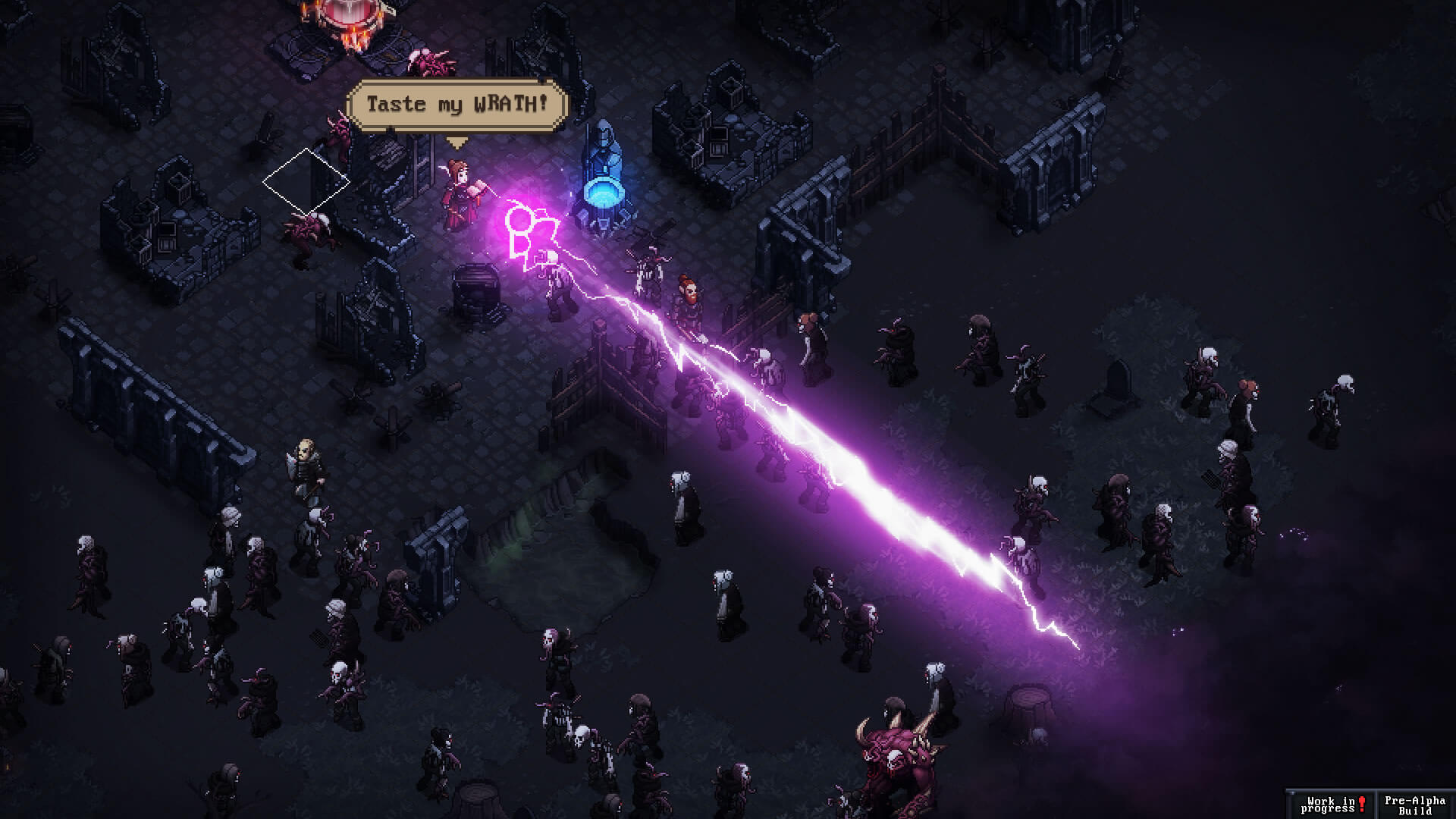The Last Spell by Ishtar Games is a cross-genre mash up, mixing turn based tactics with tower defense. In it you control a team of heroes defending one of the last remnants of civilization against the twisted remnants of your former countrymen.
Overview
The Last Spell begins with three characters in your settlement just as the first night of invasion starts.These characters are procedurally generated with one of them wielding a melee weapon, the second a ranged weapon, and the third a magical weapon. You are immediately thrown into the thick of things, with a horde of monsters heading towards the magical circle that is the last hope of humanity. If you survive this first night you will end up in a day turn, which is basically a preparation phase. During this phase, you level up your characters, construct buildings, erect defenses, and use workers to advance your overall economy. You level up your characters, construct buildings, erect defenses, and use your workers to advance your overall economy. After managing your city, you place your heroes so they can properly react to the increasingly incoming waves and do it again. This continues until you reach the final night, face off against a unique wave of enemies and a boss, and win the game or lose and start over again.
Combat is turn-based with each character having a number of action points and movement points based on their starting traits, gear, and meta unlocks. Each ability has an action cost, many have a mana cost, and some have a movement cost though generally you are going to just be using movement for positioning. This positioning is very dynamic however, with potential for jumping over walls and climbing up watchtowers in addition to covering distance. Actions are almost entirely determined by what weapon you currently have in your hands, and there are no restrictions for a particular character using whatever they want. The wide variety of weapon capabilities, odd extra capabilities from other gear slots, and the few perks that give free actions leave an array of choices on any given round.Which is good because you are vastly, vastly outnumbered and have to be able to take full advantage of your capabilities in order to survive.
Enemy types vary, but are generally tightly-constrained by the stage you are on. There is some variance in regard to what the mid-level and top-level enemies are featured, with one building having an upgrade that lets you reroll which one are present. However, generally you aren’t going to see a specific enemy type before you get far enough along in the game. This aspect gives a nice sense of progression, even if you fail, since you can start conceptualizing how you would go about beating the specific roadblock you faced in future runs.
Every enemy defeated grats tainted essence, which you can utilize to purchase meta upgrades. Specific in-game achievements also unlock upgrades, which frankly, are quite numerous and touch on every aspect of the game. Said meta-upgrades provide more gear options, buff starting characters, improvements to the starting base, unlock more buildings for your base, and improve the quality of your production buildings. Whether this is a good or bad thing will depend on your overall perspective on meta progression. The game locks certain buildings that are almost essential to winning behind meta progression. This can be frustrating if you want to be able to win in your first few runs, but for those who like having unlocks and “carrots” to drive you forward in playing, this can be quite pleasant and provides some framework on how to explore the game.
The characters feature many attributes that impact how they perform, both offensively and defensively. The abilities which a given character may favor or find important depends greatly on the character’s role and is further refined by the type of weapon they use. Some stats are more-generally-useful, however, the more-specialized stats often end up being more-valuable with the specific weapons that utilize them. When a character levels up, they get to pick one of five different potential upgrades for primary attributes, then another set for secondary attributes. In addition to the randomization of the offered attribute, the scope of the improvement is always varied, with Uncommon and Rare upgrades offering bigger bonuses or access to attributes that aren’t available on the Common level. For example AP is only available at the Rare level, and Move on the Uncommon and Rare level.
Characters additionally get a choice of perks when they level up, with higher-ranked perks requiring multiple purchases of lower-rank perks before they become available. These perks provide an additional level of customization that is inherent to your character, rather than gear or starting trait specific. These vary in power level from very skippable to must have, but the bulk of them are in the muddled middle. Perk balance will hopefully be reviewed by Ishtar Games as Early Access progresses. For the time being, however, while you will still need to weigh and evaluate the perks, you will likely find that the majority of them are not that useful.
Reasons to Get It Now
I admit that I largely tend to avoid getting Early Access games. Not out of any mistrust for developers or anger over the fact that the game is not perfect, but because I fear that I will get burnt out on going too deep into the story, particularly if there is a chance progress will be reset. Games based on individual runs, essentially roguelikes and roguelites, are different. These frequently feature meta-progression which can help inspire replays and at the very least use procedural generation to provide a wide array of starting configurations and overall arc in order to provide replay value and decrease burn out. The Last Spell does this well with the starting characters and gear you get access to. If you designed your characters and had perfect access to all gear then The Last Spell would have pretty poor replay value, but that is generally true of roguelites. If this is something you enjoy, you will likely enjoy The Last Spell even now. If it is not, then it is probably better to skip it entirely.
The Last Spell is also, in my opinion, really fun. It doesn’t reinvent the wheel, but that isn’t necessary to have a good game. It is not really reinventing the wheel, but to have a successful game that is not necessary at all. What it does provide is a distinct combination of play experiences and a granular decision space that lets you sink your teeth deep into all of the options that are available and how small changes can have big impacts on your success. I have already played over 40 hours in it, and would likely continue to explore configurations and options if it was not for other games I needed to write about and a general desire to see how the game evolves before I dive back in. I may do it anyway depending on how my gaming time and my writing requirements evolve.
Reasons to Wait or Skip
The game needs some polishing. It still had some bugs, and areas where the interface could improve and balance, both between weapon types and perks, is fairly poor at the moment. This will likely improve. The Last Spell seems to have gotten a lot of traction among players, so these things should get better over time, but if you are unlikely to tolerate having a big gulf between various options, then it is definitely better to wait for now.
As noted above, the game relies heavily on meta-progression to make a compelling game experience. Whether this is a problem or not for you will likely depend on your personal perspective on it, but it is worth noting that the Last Spell leans especially hard on it. Some games, such as Wind and the Wilting Blossom and Curious Expedition 2 feature it as a form of flavor. It provides additional options and may provide a steady increase in overall power level, but if you are good enough you can definitely win with little or none of it. The Last Spell is different. It relies on this meta progression extremely heavily, to the point where you will definitely not win your first run, and winning later runs increases exponentially every time you lose and more and more of the game opens up to you.
Because of how heavy-handed the meta-progression is, I am somewhat skeptical of the idea pushed by the developers that The Last Spell is a difficult game. Winning in the first few runs is very difficult, sure, but as time goes on the difficulty steadily goes down until it reaches a very manageable level. Of course you can increase the difficulty after you beat the game, but this is pretty typical of roguelikes and doesn’t make the Last Spell stand out.
Conclusion
The Last Spell is in the class of games that are generally worth playing in Early Access: meta-progression driven roguelites. It already looks like it is going to be a particularly good member of this class, and is one that I will be watching with deep interest as it moves forward towards release. Its poor balance is something to be concerned about, but is not that unusual for something just hitting early access. If you like roguelites and poor balance is not a major concern for you then it is definitely worth checking out now. If not I would suggest you give it some more time for the developer’s to work out the kinks or for a full release.







